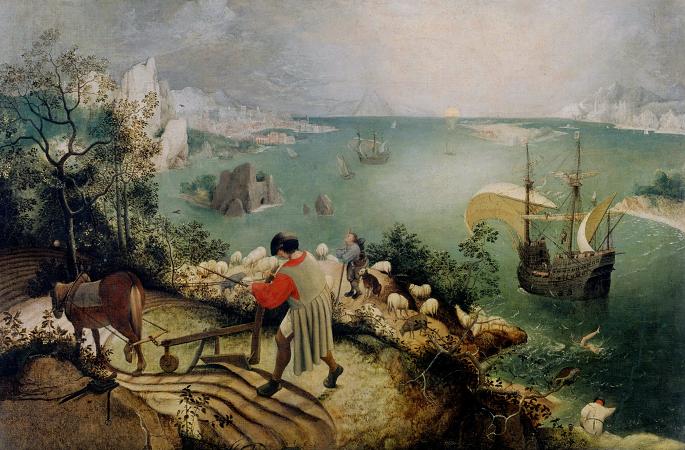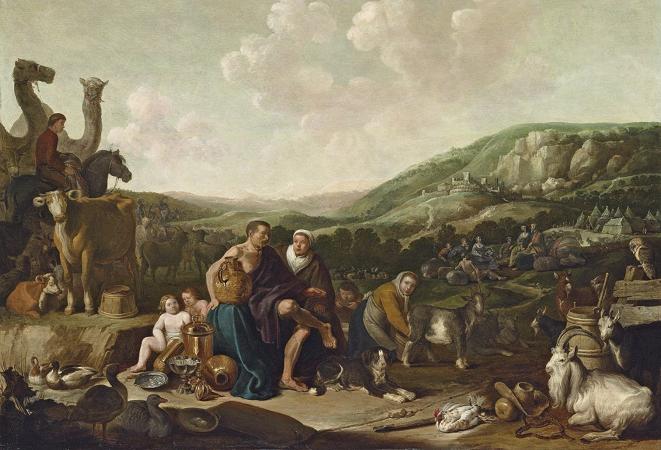Roelandt Savery (1576 - 1639). Roelant Savery was a Flanders-born Dutch Golden Age painter. Savery was born in Kortrijk. Like so many other artists, he belonged to an Anabaptist family that fled north from the Spanish-occupied Southern Netherlands when Roelant was about 4 years old and settled in Haarlem around 1585. He was taught painting by his older brother Jacob Savery and Hans Bol. After his schooling, Savery traveled to Prague around 1604, where he became court painter of the Emperors Rudolf II and Mathias, who had made their court a center of mannerist art. Between 1606 and 1608 he traveled to Tyrol to study plants. Gillis d'Hondecoeter became his pupil. Before 1616 Savery moved back to Amsterdam, and lived in the Sint Antoniesbreestraat. In 1618 he settled in Utrecht, where he joined the artist's guild a year later. His nephew Hans would become his most important assistant. In 1621 Savery bought a large house on the Boterstraat in Utrecht. The house had a large garden with flowers and plants, where a number of fellow painters, like Adam Willaerts were frequent visitors. Savery had kept his house in Amsterdam, and had one child baptized in Nieuwe Kerk. Savery was friends with still life painters like Balthasar van der Ast and Ambrosius Bosschaert. In the 1620s he was one of the most successful painters in Utrecht, but later his life got troubled, perhaps because of heavy drinking. Though he would have pupils until the late 1630s, amongst which Allaert van Everdingen and Roelant Roghman, he went bankrupt in 1638 and died in Utrecht half a year later. Savery primarily painted landscapes in the Flemish tradition of Gillis van Coninxloo, often embellished with many meticulously painted animals and plants, regularly with a mythological or biblical theme as background. He also painted multiple flower still lifes; bouquets in stone niches, sometimes with lizards, insects or fallen petals and regarded as his best work. His unique style of painting, related to the then reigning Mannerism, has been highly popular with collectors and can be found in many museums in Europe and North America. His preparatory drawings are also valued highly. Among his best-known works are several depictions of the now-extinct dodo painted between 1611 and 1628. His nephew Hans a.k.a. Jan Savery was also known for his paintings of the dodo, which he probably copied from his uncle's work. Savery is famous for being the most prolific and influential illustrator of the extinct dodo, having made at least ten depictions, often showing it in the lower corners. A famous painting of his from 1626, now called Edwards' Dodo as it was once owned by the ornithologist George Edwards, has since become the standard image of a dodo. It is housed in the Natural History Museum, London. This and his other images are the source for many other dodo illustrations. Media related to Roelant Savery at Wikimedia Commons Savery at WGA. Savery at the Artcyclopedia. Whale on the beach. Tyrolean landscape. Pieter Bruegel the Elder: Drawings and Prints, a full text exhibition catalog from The Metropolitan Museum of Art, which includes material on Roelant Savery. 17 paintings by or after Roelant Savery at the Art UK site. Authority control. Categories: 1576 births. 1639 deaths. Dutch Golden Age painters. Dutch male painters. Flemish Baroque painters. Dutch bird artists. Dutch still life painters. People from Kortrijk. Artists from Utrecht. Members of the Utrecht Guild of Saint Luke. Sibling artists. Hidden categories: All articles with dead external links. Articles with dead external links from April 2018. Articles with permanently dead external links. Articles with dead external links from January 2018. Commons category link from Wikidata. Wikipedia articles with AAG identifiers. Wikipedia articles with AGSA identifiers. Wikipedia articles with BNE identifiers. Wikipedia articles with BNF identifiers. Wikipedia articles with BPN identifiers. Wikipedia articles with DSI identifiers. Wikipedia articles with GND identifiers. Wikipedia articles with ISNI identifiers. Wikipedia articles with KULTURNAV identifiers. Wikipedia articles with LCCN identifiers. Wikipedia articles with NKC identifiers. Wikipedia articles with NLA identifiers. Wikipedia articles with NTA identifiers. Wikipedia articles with RKDartists identifiers. Wikipedia articles with SNAC-ID identifiers. Wikipedia articles with SUDOC identifiers. Wikipedia articles with TePapa identifiers. Wikipedia articles with ULAN identifiers. Wikipedia articles with VIAF identifiers. Wikipedia articles with WorldCat-VIAF identifiers. Use dmy dates from May 2011.
more...














